Mowry Baden’s art has deep Pomona College roots. He started here as a student and then came back to campus later as an art professor, department chair and gallery director from 1968 to 1971.
Long based in Victoria, B.C., Baden ’58 is known for his large-scale kinesthetic sculptures. “Dromedary Mezzanine,” on view at the Pomona College Museum of Art through April 13, is a tall, platformed bicycle that a museum visitor pedals to reach four wall-mounted tents containing tools—an effort that is both exercise and meditation for the participant. Baden’s body-oriented, interactive works have impacted generations of Pomona students and garnered him wide respect.
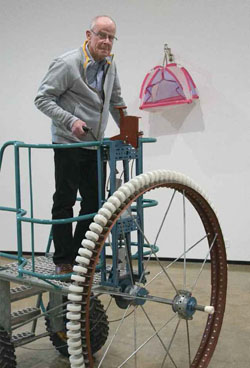 Q: What’s the philosophy behind moving sculpture?
Q: What’s the philosophy behind moving sculpture?
A: Almost all of my working life as a sculptor I’ve dedicated my energies to capitalizing on the physical energies of the period. So often people ask me, “What is your medium?” I say, exertion. Not my exertion but the exertion of the viewer, and this involves so often intercepting their habitual habits, gestural habits; intercepting those habits and sending them in unexpected directions.
So the viewer makes a discovery, or several discoveries, about the way their mind and body collaborate—and we call that kind of event an illusion, a phantom. This sculpture [“Dromedary Mezzanine”] capitalizes on the viewer’s energy. To ensure that the viewer engages with the work as long as possible, I’ve put these little destinations, chambers, high on the wall and each chamber contains a tool. When I acquired the tools I didn’t know their function; they’re very old, they’re out of use. So old are they, we have no idea how to put them into use, so that each is a mystery. This sculpture tries to do two things at once, exertion and the pausing and pondering of these mystery objects.
What do you find most compelling about this kind of work?
A: The central objective is to get into the sensory, to get in behind the external of the viewer, to surprise her with her own perceptual habits, which she thinks she knows from A to Z, but she doesn’t. So the sculpture opens a window into that internal space and she is surprised. Then another layer consists of the signaling that goes on between her and the other people in the room. So she comes, she engages with this, her friend or a stranger watches her and waits her turn. But sometimes her friend is too timid, sometimes her friend is too self-conscious, sometimes
her friend is inappropriately dressed. No matter, because just the act of watching this activity is something her friend’s brain pays acute attention to. In her brain, what are firing are synapses called mirror neurons, and we all have them. In more conventional language, we would call the firing of your neurons empathy. Then there’s another layer: gossip. She comes, she engages with the sculpture. She came alone. But she sees her friend at Starbucks and tells her what happened. Her friend comes to experience the same things, but the curious thing is she doesn’t experience the same thing. Because the two people are different. So really, that’s why I emphasize the particular, because no two people are the same. Generally the same, but particularly not. Another layer is institutional. There’s a lot of code breaking going on here. The first code is, don’t touch the art. So [a work like this] circumvents that code and invites the viewer to do something that she shouldn’t do in this no-touch world of the museum.
The fifth layer has to do with collaboration. If you come sometime to this space and watch people come in, you know how best to manage this apparatus, but they don’t. Each person engages with it unsuccessfully, but those people who view that person interacting with the sculpture take it a step further when it is their turn.
Q: How did your Pomona experience at those different stages—first as a student, then a professor, then as a gallery director—impact your art?
A: In this group of exhibitions, the museum is presenting drawings and paintings by my old teacher Frederick Hammersley…back in 1954-58. He would have us sit at our drawing places and he would say, “Put your pen right there.” [Baden tosses tissue to the floor signifying the movement.] “Now send it around.” So the idea was to keep your eye out there on the object and keep your pen traveling along its perimeter as you drew on the paper in front
of you. It could take a long time to get the line all the way around the object and often the results were startling, but they were always very physical. So your eye and your hand and your body all engage with trying to make this mark significant. He was a very good teacher and you can see how through a kind of filter it surfaces in the kind of work that I do. Then later when I taught here, then ran the department and then was gallery director, I had the good fortune to meet and work with a lot of students and with the gallery director who were more than ready to embrace the engagement of the body as an active component of a work of art. So I had wonderful colleagues like Guy Williams and David Gray in the studio program, later on Lewis Baltz. I had wonderful students like Chris Burden ’69 and Michael Brewster ’68, and I had maybe the best gallery director of the period… Hal Glicksman. So it was really, truly a golden moment in the history of this institution and I was very privileged to be a part of it.
Q: What drives your art?
A: Boredom. Just wanting to entertain yourself, right? I’ve been an artist since I was 8 years old; I don’t know how to do anything else really. At least nothing that chases boredom away so conclusively. I’m also the son of an architect, so almost all my work is larger-scale, body-size, even mini-architectural scale. And even one of my sons is an architect. So I guess in a way it kind of runs in the blood of the family. My mother was a poet. I’m just an art brat.
This interview has been abridged and edited.
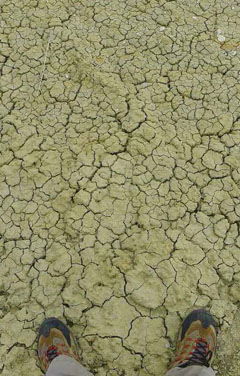 They head down Fish Creek Wash, a dry riverbed winding its way through dramatically deep stone canyons.
They head down Fish Creek Wash, a dry riverbed winding its way through dramatically deep stone canyons.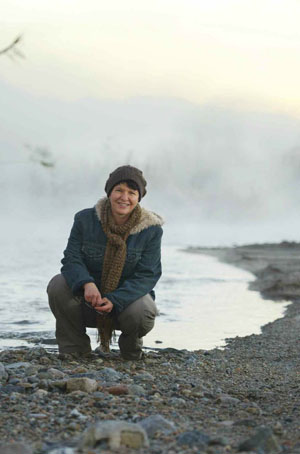 She also is drawn by the juxtaposition. Egrets, ducks and other birds wing above as unseen creatures rustle in the dry grass, a bucolic backdrop to the homeless people sleeping in tents deep in the brush, and the distant rush of commuters barreling down unseen roadways. The air carries a tinge of burning garbage as well, from breakfast campfires near the covered-over Tequesquite Landfill that Williams walked past to get here.
She also is drawn by the juxtaposition. Egrets, ducks and other birds wing above as unseen creatures rustle in the dry grass, a bucolic backdrop to the homeless people sleeping in tents deep in the brush, and the distant rush of commuters barreling down unseen roadways. The air carries a tinge of burning garbage as well, from breakfast campfires near the covered-over Tequesquite Landfill that Williams walked past to get here.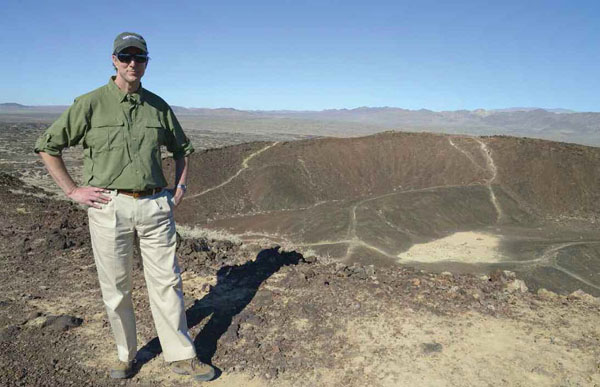
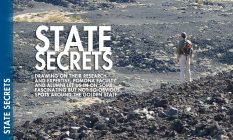
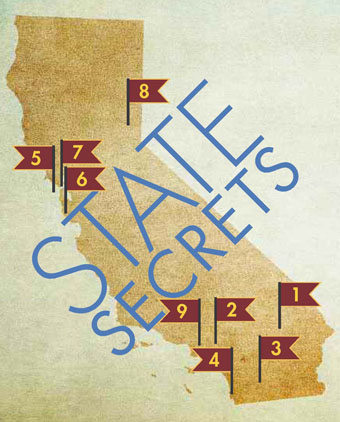 1)
1) 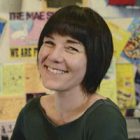
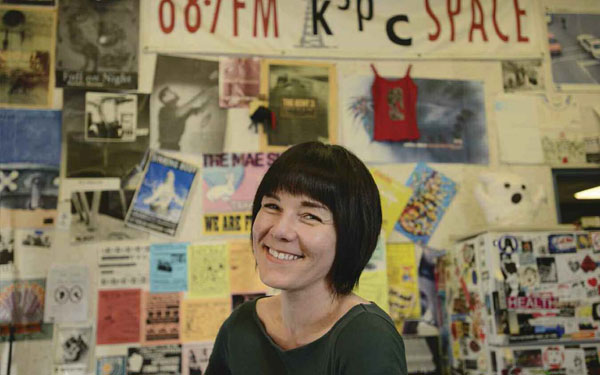
 Q: What’s the philosophy behind moving sculpture?
Q: What’s the philosophy behind moving sculpture?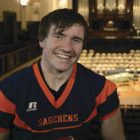
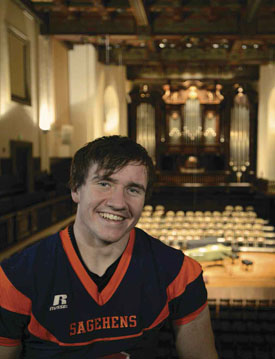 Teamwork
Teamwork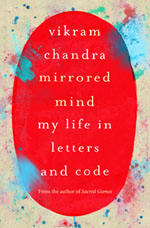 The latest from Chandra, author of the bestseller Sacred Games, is
The latest from Chandra, author of the bestseller Sacred Games, is 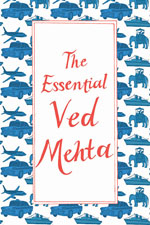 Ved Mehta ’56, the author of 27 books and many articles, has released
Ved Mehta ’56, the author of 27 books and many articles, has released 